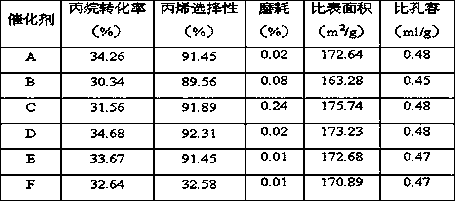A kind of low-carbon alkane dehydrogenation olefin catalyst and preparation method thereof
A low-carbon alkane and catalyst technology, which is applied in the field of low-carbon alkane dehydrogenation to olefin catalyst and its preparation, can solve the problems of clogging secondary pores, changing the internal structure of pores, etc., achieves improved mechanical strength, simple preparation method, and is suitable for The effect of industrial production
- Summary
- Abstract
- Description
- Claims
- Application Information
AI Technical Summary
Problems solved by technology
Method used
Image
Examples
Embodiment 1
[0037] Catalyst preparation:
[0038] (1) Weigh an appropriate amount of chloroplatinic acid, dissolve it in deionized water, and impregnate 10kg of Al containing Sn 2 o 3 carrier, the immersion time is 3h. Then place it in a drying oven for drying, the drying temperature is 110° C., and the drying time is 6 hours. Then it is placed in a muffle furnace for calcination, the calcination temperature is 600°C, and the calcination time is 6h.
[0039] (2) The mass water absorption rate of the catalyst obtained after roasting was measured to be 75%. An appropriate amount of zinc nitrate and potassium nitrate was prepared into an aqueous solution with 7.37kg of ionized water, and the catalyst obtained in step (1) was impregnated to make it absorb water to saturation.
[0040] (3) Evenly spread the catalyst that has absorbed water to saturation on the drying belt with a thickness of 3.5cm. Control the transmission speed of the drying belt to 50m / h, the drying temperature to 150°C, ...
Embodiment 2
[0051] Catalyst preparation:
[0052] (1) Weigh an appropriate amount of chloroplatinic acid, dissolve it in deionized water, and impregnate 10kg of Al containing Sn 2 o 3 carrier, the immersion time is 6h. Then place it in a drying oven for drying, the drying temperature is 120° C., and the drying time is 5 hours. Then place it in a muffle furnace for calcination, the calcination temperature is 550°C, and the calcination time is 5h.
[0053] (2) The mass water absorption rate of the catalyst obtained after roasting was measured to be 75%, and an appropriate amount of lanthanum nitrate was prepared into an aqueous solution with 7.36 kg of ionized water, and the catalyst obtained in step (1) was impregnated to make it absorb water to saturation.
[0054] (3) Spread the catalyst that has absorbed water to saturation evenly on the drying belt with a thickness of 4cm. Control the transmission speed of the drying belt to 45m / h, the drying temperature to 140°C, and pass through t...
Embodiment 3
[0059] Catalyst preparation:
[0060] (1) Dissolve an appropriate amount of chloroplatinic acid in deionized water, and impregnate 10kg of Al containing Sn 2 o 3 carrier, the immersion time is 4h. Then place it in a drying oven for drying, the drying temperature is 110° C., and the drying time is 5 hours. Then place it in a muffle furnace for calcination, the calcination temperature is 650°C, and the calcination time is 5h.
[0061] (2) The mass water absorption rate of the catalyst obtained after calcination was measured to be 66%, and an appropriate amount of gallium nitrate was prepared into an aqueous solution with 7.38 kg of ionized water, and the catalyst obtained in step (1) was impregnated to make it absorb water to saturation.
[0062] (3) Spread the catalyst that has absorbed water to saturation evenly on the drying belt with a thickness of 4cm. Control the transmission speed of the drying belt to 45m / h, the drying temperature to 140°C, and pass through the 40m lo...
PUM
| Property | Measurement | Unit |
|---|---|---|
| thickness | aaaaa | aaaaa |
| specific surface area | aaaaa | aaaaa |
| pore size | aaaaa | aaaaa |
Abstract
Description
Claims
Application Information
 Login to View More
Login to View More - R&D
- Intellectual Property
- Life Sciences
- Materials
- Tech Scout
- Unparalleled Data Quality
- Higher Quality Content
- 60% Fewer Hallucinations
Browse by: Latest US Patents, China's latest patents, Technical Efficacy Thesaurus, Application Domain, Technology Topic, Popular Technical Reports.
© 2025 PatSnap. All rights reserved.Legal|Privacy policy|Modern Slavery Act Transparency Statement|Sitemap|About US| Contact US: help@patsnap.com


